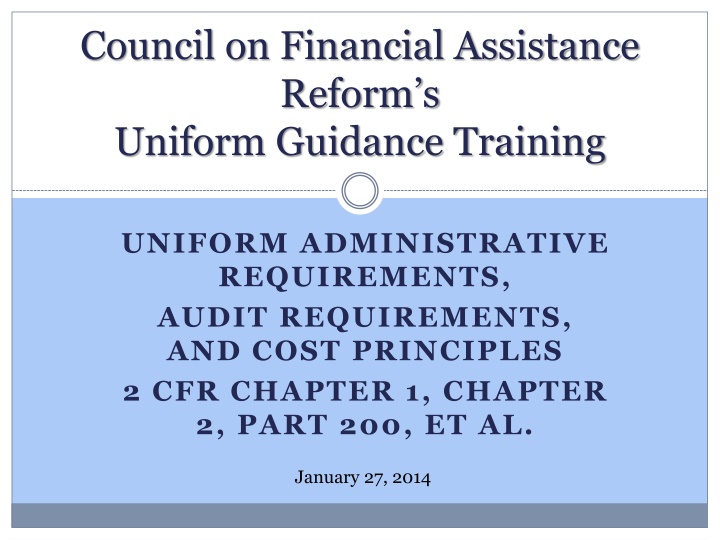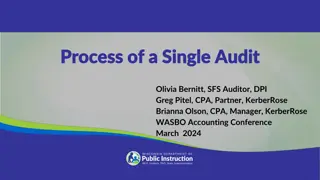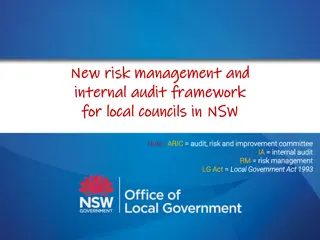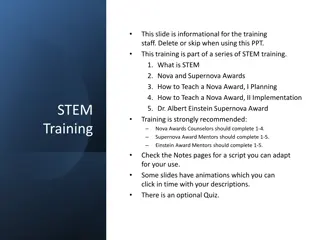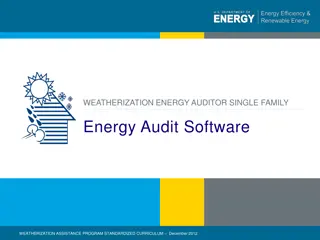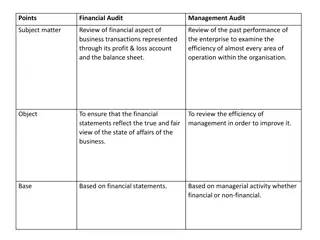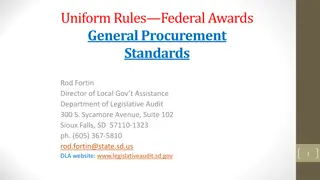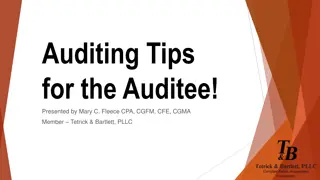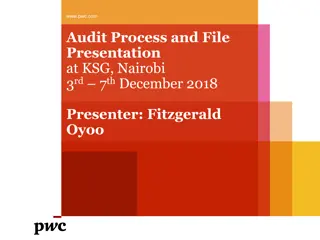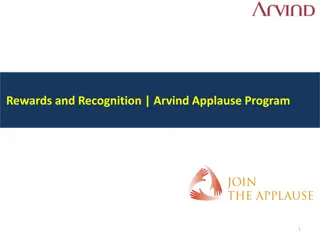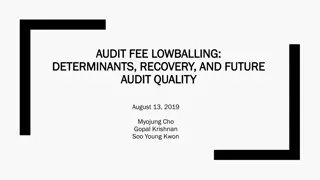Reforming Audit Requirements for Federal Awards
This presentation outlines the major policy changes in the government-wide requirements for auditing Federal awards under the Single Audit Act Amendments of 1996. It discusses the transition from OMB Circular A-133 to Subpart F-Audit Requirements in 2 CFR Part 200, focusing on targeting audit requirements based on the risk of waste, fraud, and abuse to enhance transparency and accountability. The revisions aim to strengthen the audit process by increasing thresholds, adopting a risk-based approach for Major Programs, and promoting public outreach for compliance. The structure of the Single Audit Process remains foundational with key elements such as audit thresholds, subrecipient versus contractor distinctions, biennial and program-specific audits, auditor selection, financial statement preparation, follow-up actions, reporting timelines, and major program determinations based on risk.
Download Presentation

Please find below an Image/Link to download the presentation.
The content on the website is provided AS IS for your information and personal use only. It may not be sold, licensed, or shared on other websites without obtaining consent from the author.If you encounter any issues during the download, it is possible that the publisher has removed the file from their server.
You are allowed to download the files provided on this website for personal or commercial use, subject to the condition that they are used lawfully. All files are the property of their respective owners.
The content on the website is provided AS IS for your information and personal use only. It may not be sold, licensed, or shared on other websites without obtaining consent from the author.
E N D
Presentation Transcript
Council on Financial Assistance Reform s Uniform Guidance Training UNIFORM ADMINISTRATIVE REQUIREMENTS, AUDIT REQUIREMENTS, AND COST PRINCIPLES 2 CFR CHAPTER 1, CHAPTER 2, PART 200, ET AL. January 27, 2014
Audit Requirements REFORMSTO CIRCULARS A-133 AND A-50 January 27, 2014
Audit Requirements Presented by: Terry Ramsey, Senior Technical Advisor, Department of Health and Human Services
Audit Requirements 4 This presentation highlights the major policy changes to the government-wide requirements for audit of Federal awards under the Single Audit Act Amendments of 1996. These audit requirements are currently found in OMB Circular A-133, Audits of States, Local Governments, and Non-Profit Organizations and will be replaced by Subpart F-Audit Requirements in 2 CFR Part 200 which was published in the Federal Register on December 26, 2013.
Targeting Audit Requirements on Risk of Waste, Fraud, and Abuse 5 The final guidance right-sizes the footprint of oversight and Single Audit requirements to strengthen oversight and focus audits where there is greatest risk of waste, fraud, and abuse of taxpayer dollars. It improves transparency and accountability by making single audit reports available to the public online, and encourages Federal agencies to take a more cooperative approach to audit resolution in order to more conclusively resolve underlying weaknesses in internal controls.
Revisions Focus Audit On Risk 6 Increases audit threshold. Strengthens risk-based approach to determine Major Programs. Provides for greater transparency of audit results. Strengthens agency use of the single audit process. Provides for public outreach to focus Compliance Supplement on requirements of highest risk.
Basic Structure of Single Audit Process Unchanged 7 Audit threshold (200.501). Subrecipient vs. Contractor (200.501(f) & 200.330). Biennial (200.504) & Program-specific (200.507) audits. Non-Federal entity selects auditor (200.509). Auditee prepares financial statements & SEFA(200.510). Audit follow-up & corrective action(200.511 & 200.521). 9 month due date (set in law) (200.512(a)). Reporting to Federal Audit Clearinghouse (200.512). Major programs determined based on risk (200.518). Compliance Supplement overall format.
Audit Threshold (200.501) 8 The COFAR considered that raising the threshold would allow Federal agencies to focus their audit resolution resources on the findings that put higher amounts of taxpayer dollars at risk, thus better mitigating overall risks of waste, fraud, and abuse across the government. Further, the COFAR notes that provisions throughout the guidance, including pre-award review of risks, standards for financial and program management, subrecipient monitoring and management, and remedies for noncompliance provide a strengthened level of oversight for non-Federal entities that would fall below the new threshold.
Audit Threshold 9 Increases audit threshold from $500,000 to $750,000. Maintains oversight over 99.7% of the dollars currently subject Single Audit and reduces audit burden for approximately 5,000 entities. Increase of $250,000 is in line with previous threshold increase in 2003.
Major Program Determination 10 200.518 Major Program Determination focuses audits on the areas with internal control deficiencies that have been identified as material weaknesses. Future updates to the Compliance Supplement will reflect this focus as well.
Type A/B Threshold Step 1 11 Programs are grouped based on dollars. Type A programs are those above the threshold. Type B are those below the threshold. Type A/B threshold is a sliding scale with minimum. Minimum increases from $300,000 to $750,000. Threshold presented in table to be more easily understood. Audit threshold and Type A/B minimum threshold will be the same at $750,000.
Type A/B Threshold Table (200.518(b)(1)) 12 Type A/B Threshold $750,000 Total FAE times .03 $3,000,000 Total FAE times .003 $30M Total FAE times .0015 Total Federal Awards Expended (FAE) Equal to $750,000 but LT or EQ to $25 M Exceed $25M but LT or EQ to $100M Exceed $100M but LT or EQ to $1B Exceed $1B but LT or EQ to $10B Exceed $10B but LT or EQ to $20B Exceed $20B M means Million Dollars and B means Billion Dollars. LT means Less Than. EQ means Equal To.
High-Risk Type A Program (200.518(c)) (Step 2) 13 Current A-133 criteria: Not audited as major program in 1 of 2 most recent audit periods. In most recent period had ANY AUDIT FINDING. Provided for auditor judgment in limited cases, e.g., very small questioned costs. Other Auditor judgment - Oversight exercised by Federal agencies or pass-through entities, audit follow-up, or changes in personnel or systems which significantly increased risk. Uniform Guidance: SAME. In most recent period had a HIGH- RISK AUDIT FINDING: Modified opinion. Material weakness in internal control. Known or likely questioned costs exceeding 5% of total program expenditures. Other Auditor judgment. Basically unchanged. Key An entity with strong internal controls and few audit findings will have less high-risk Type A program.
High-Risk Type B Program (200.518(d)) (Step 3) 14 New criteria: Perform risk assessments on Type B programs until high-risk Type B programs have been identified UP TO at least 25% of number of low- risk Type A programs Current A-133 criteria: Currently there are two Type B risk assessment options: Option 1 Perform risk assessments on ALL Type B programs and select at least 50% of Type B programs identified as high risk up to number of low-risk Type A programs Option 2 Perform risk assessments on all Type B programs until as many high-risk Type B programs have been identified as there are low-risk Type A programs.
Percentage of Coverage Rule (200.518(f)) (Step 4) 15 Guidance reduces the minimum coverage as follows: Type of Auditee Current New Not low-risk 50% 40% Low-risk 25% 20%
Low-Risk Auditee 16 200.520 Criteria for a Low-Risk Auditee Members of the audit community and states commented on the criteria for a low-risk auditee that includes whether the financial statements were prepared in accordance with GAAP. Members of the audit community note that GAAP is the preferred method, and states note that state law sometimes provides for other methods of preparation. The COFAR considered this and recommended revised language to allow for exceptions where state law requires otherwise.
Low-Risk Auditee (200.520) 17 New (2 prior years) SAME. Unmodified opinions on statements in accordance with GAAP or basis of accounting required by state law. SAME. Current (2 prior years) Annual single audits Unmodified opinion on financial statements in accordance with GAAP Unmodified SEFA in relation to opinion. No GAGAS material weaknesses In either of preceding two years, none of Type A programs had: Material Weakness. Material noncompliance. Questioned costs that exceed 5%. Timely filing with FAC. Auditor reporting going concern not preclude low-risk. Waivers. SAME. SAME SAME. No Audit reporting of going concern. No waivers.
Single Audit Report Submission 18 200.512 Report Submission requires publication of Single Audit Reports online with safeguards for protected personally identifiable information and an exception for Indian tribes in order to reduce the administrative burden on non-Federal entities associated with transmitting these reports to all interested parties.
Single Audit Report Submission (Contd) 19 All auditees must submit the reporting package and the data collection form electronically to the Federal Audit Clearinghouse (FAC) (200.512(d)). FAC submission process will be changed to require that submissions be in text-based PDF and unlocked to improve accessibility. FAC responsible to make the reports available on a Web site (200.512(g)). Exception for Indian tribes will be discussed later.
Single Audit Reports on the Web - PPII 20 Auditors and auditees must ensure reports do not include protected personally identifiable information (PPII) (200.82 & 200.512(a)(2)). Auditee must sign statement that (200.512(b)(1)): Reports do not include PPII. Authorizes FAC to make reports publically available on a Web site. Exception for Indian tribes as defined in 200.54. No exception for tribal organization not meeting the 200.54 definition.
Exception for Indian Tribes (200.512(b)(2)) 21 Tribal reports may include confidential business information that would be redacted under the Freedom of Information Act. May elect to not authorize the FAC to make reporting package publically available on the a Web site. If elected, Indian tribe must: Submit reporting package directly to pass-through entities. Make reporting package available for public inspection as required by the Single Audit Act.
FAC Repository of Record for Reporting Packages (200.36 & 200.512(b)) 22 Federal agencies, pass-through entities, and others obtain copies by accessing FAC website. Subrecipient only required to submit report to FAC and no longer required to submit to pass-through entity. Pass-through entity no longer required to retain copy of subrecipient report as available on the Web.
Single Audit Accountable Official 23 200.513 Responsibilities requires Federal awarding agencies to designate a Senior Accountable Official who will be responsible for overseeing effective use of the Single Audit process and implementing metrics to evaluate audit follow-up.
Single Audit Accountable Official (200.513(c)(5)) 24 Ensure agency effectively uses the single audit process. Develop a baseline, metrics, and targets to track, over time, the effectiveness of: The agency s process to follow-up on audit findings. Single Audits in: Improving non-Federal entity accountability for Federal awards. Use by the agency in making award decisions. Designate the agency s Key Management Single Audit Liaison.
Agency Key Management Single Audit Liaison (200.513(c)(6)) 25 Agency management s point of contact for single audit. Promote interagency coordination. Oversee training for agency s program management personnel related to the single audit process. Promote use of cooperative audit resolution. Coordinate agency s audit follow-up to ensure timely corrective action on audit findings. Organize cognizant agency for audit follow-up. Ensure agency provides annual updates to the Compliance Supplement. Support the Senior Audit Accountable Official.
Cooperative Audit Resolution 26 200.513(c)(3)(iii) Responsibilities encourages Federal awarding agencies to make effective use of cooperative audit resolution practices in order to reduce repeat audit findings.
Cooperative Audit Resolution (200.25) 27 Cooperative audit resolution means the use of audit follow-up techniques which promote prompt corrective action by improving communication, fostering collaboration, promoting trust, and developing an understanding between the Federal agency and the non-Federal entity. This approach is based upon: (a) A strong commitment by Federal agency and non-Federal entity leadership to program integrity; (b) Federal agencies strengthening partnerships and working cooperatively with non-Federal entities and their auditors; and non-Federal entities and their auditors working cooperatively with Federal agencies; (c) A focus on current conditions and corrective action going forward; (d) Federal agencies offering appropriate relief for past noncompliance when audits show prompt corrective action has occurred; and (e) Federal agency leadership sending a clear message that continued failure to correct conditions identified by audits which are likely to cause improper payments, fraud, waste, or abuse is unacceptable and will result in sanctions.
Appendix XI - Compliance Supplement 28 While most commenters were in favor of the proposed reduction of the number of types of compliance requirements, many voiced concern about the process to implement such changes. Comments questioned whether Federal agencies adding back provisions under special tests and provisions would result in increased administrative burden. Since the Supplement is published as part of a separate process, the COFAR recommended that any future changes to its structure be based on available evidence of impact on past findings and include further public outreach to mitigate potential risks of an inadvertent increase in administrative burden.
Compliance Supplement 29 Supplement is published as separate process so the final changes are not included in the Guidance. Future changes will be based on available evidence of past audit findings & potential impact of non- compliance. Further public outreach will be conducted prior to making structural changes to Supplement format. 2014 Supplement will preview the implementation of changes. Changes will not be effective until the 2015 Supplement. 2014 Supplement expected in April 2014.
Audit Findings (200.516) 30 Increases the threshold for reporting known and likely questioned costs from $10,000 to $25,000 (200.516(a)(3) & (4)). Requires that questioned costs be identified by CFDA number and applicable award number (200.516(b)(6)). Requires Identification of whether audit finding is a repeat from the immediately prior audit and if so the prior year audit finding number (200.516(b)(8)). Provides that audit finding numbers be in the format prescribed by the data collection form (200.516(c)).
Additional Audit Requirements 31 List of program specific audit guides will be provided beginning with the 2014 Supplement including (200.517(a)): Agency contact information. Web site where copy of guide is available. Clarified that if report due date is on a Saturday, Sunday, or Federal legal holiday, report submission is due the next business day (200.512(a)). Provides for a government-wide audit quality project once every 6 years beginning in 2018 (200.513(a)(3)(ii)). Made technical edits to align with current auditing standards.
Additional Audit Requirements Future Changes 32 Included language to allow for future combining of the audit reporting and the data collection form if permitted under auditing standards and the approved FAC data collection (200.515(e)). Single Audit resolution project currently under supervision of COFAR is aimed at improving coordination for cross-cutting findings and improving transparency of management decisions.
Effective Date for Audit Requirements (200.110(b)) 33 Subpart F will be effective for non-Federal entity Fiscal Years (FY) or biennial periods beginning on or after December 26, 2014. First year examples: FY beginning January 1, 2015 and ending December 31, 2015. Biennial period beginning January 1, 2015 and ending December 31, 2017. Early implementation of Subpart F is not permitted.
Audit Requirements 34 Thank you for your time and attention! Please submit questions to cofar@omb.eop.gov. All questions will be reviewed and some may be included in a frequently asked questions document that will be posted on the COFAR website, https://cfo.gov/cofar/.
